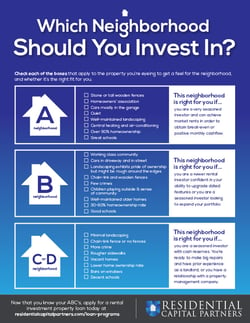Rental properties continue to be a popular investment option, offering the potential for steady passive income and long-term financial security. However, success in this area requires careful planning, knowledge of the market, and a clear investment strategy. Whether you’re a seasoned investor or new to real estate, we've outlined four of the most important things to consider when investing in rental properties today.

1. Know the Neighborhood
One of the most critical steps in choosing a rental property is understanding the neighborhood in which you're investing. Knowledge of local amenities and future developments can make a huge difference in your investment's profitability. For example, proximity to good schools, shopping centers, or transportation hubs can increase property value and rental demand. Are there plans for new corporate offices or retail developments nearby? Understanding local factors can help you pick a location with solid long-term potential.
In addition, it’s essential to be aware of neighborhood crime rates and community features. These factors impact tenant retention and property appreciation over time.
For help on your journey from rehab to rental, download this free investment rental property neighborhood checklist
2. Choose the Right Type of Property
Selecting the right property is another crucial factor. Whether you're considering condos, single-family homes, or multi-family properties, each type has its pros and cons, depending on your investment strategy and goals.
- Condos: These tend to be lower maintenance because the homeowners' association often handles exterior repairs and landscaping. While this might reduce your day-to-day involvement, the downside is that condos typically produce lower rental income, and appreciation may be slower.
- Single-family homes: These are often more affordable to purchase than multi-family units but come with the risk of 100% vacancy when a tenant moves out. The flip side is that single-family homes often appreciate faster and can offer higher long-term returns.
- Multi-family properties: With multiple units, there’s less risk of complete vacancy, and they generally provide higher cash flow. However, they usually require a larger upfront investment and more intensive management due to the number of tenants.
Choosing the best type of property depends on your budget, risk tolerance, and how hands-on you want to be with property management.
3. Target the Right Neighborhood Class
Real estate investors commonly classify neighborhoods into A, B, C, and D categories based on factors like income levels, crime rates, and property conditions.
- A Neighborhoods: These areas have high homeownership rates and low crime but require high home prices and rents to justify the investment. While they offer long-term appreciation, the upfront costs can be risky for less experienced investors.
- B Neighborhoods: These are the sweet spot for many investors. They offer a good balance of affordability and rental demand, often located in working-class communities where property values are stable or growing. About 30-60% of homes in B neighborhoods are rented, making these areas ideal for cash flow while offering solid appreciation potential.
- C and D Neighborhoods: These areas often come with higher vacancy rates, property degradation, and crime. While some seasoned investors may turn a profit by rehabbing properties here, it's not advisable for beginners. C and D neighborhoods require extensive renovation and management efforts to see returns, making them riskier for those without experience.
If you’re just starting, focus on investing in B neighborhoods where there’s a balance of opportunity and growth potential.
4. Plan Your Financing Strategy
Financing plays a pivotal role in any real estate investment. After securing short-term money to fund a rehab, you’ll need to decide how to finance the property long-term. Are you aiming for positive monthly cash flow, or are you more focused on paying off the mortgage quickly while the property appreciates in value?
Opting for a longer amortization period (20 or 30 years) typically results in a lower monthly payment, allowing for positive cash flow. On the other hand, a shorter term means higher payments but faster equity buildup. Even if you have the cash to purchase a property outright, taking out a mortgage can be a smart move to preserve liquidity and invest in additional properties down the line.
In short, careful financial planning will ensure that your rental property provides both cash flow and long-term appreciation, and partnering with an experienced, knowledgeable lender can make all the difference. Stay informed and invest wisely to maximize the profitability of your rental property.
Don't forget to download our free investment rental property neighborhood checklist to guide your journey from rehab to rental!





